This website is created by a vintage computer enthusiast and is dedicated to the legendary Apple Computer 1 — the very first computer from one of today’s most valuable companies. From a historical standpoint, the Apple-1 may not be the most important computer, but it was one of the most significant.
It was the cornerstone on which the Apple Corporation was built. Without this first computer, Apple might not exist.
APPLE-1.INFO and APPLE-1.ORG ARE NOT ASSOCIATED IN ANY WAY WITH APPLE INC.
Here you can find the official Apple Inc. website. The Apple-1 was the first ever product and computer distributed by Apple.
This website has no ads, does not use cookies, will not track you, and is hosted in the European Union.
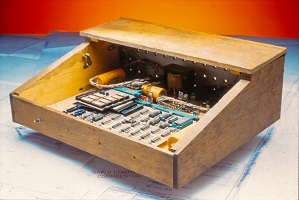 +
Apple-1 prototype
+
Apple-1 prototype
The Apple-1 computer is the most valuable microcomputer.
In 1976, engineer Steve Wozniak, while working at HP, built the Apple-1 computer from scratch. He finished his work in March 1976. Together with Steve Jobs and Ronald G. Wayne, both working for Atari, they founded the company Apple Computer, which would make history and change the world.
Before Steve Wozniak created the Apple-1, he built a transistor-based calculator at just 13 years old, and at the age of 19, a computer called the Cream Soda Computer together with Bill Fernandez. Bill Werner got the chips for it. Bill Fernandez also introduced Steve Jobs to Steve Wozniak.
Later, Steve Wozniak and Steve Jobs sold illegal phone phreaking devices, called Blue Boxes. These were invented by John Draper, aka Captain Crunch. Steve Wozniak (aka Crazy Polack) met him and began building his own Blue Boxes. Wozniak once tried to prank-call the Pope using a Blue Box, pretending to be Henry Kissinger.
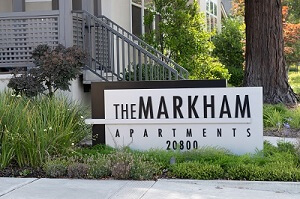 Steve Wozniak designed the Apple-1. Only 200 Apple-1 units were produced in total. According to Steve Wozniak, 175 were originally assembled.
Steve Wozniak designed the Apple-1. Only 200 Apple-1 units were produced in total. According to Steve Wozniak, 175 were originally assembled.
Steve Wozniak wrote in an email that a few were made in a pre-production run. This is supported by photos of Apple #2 listed in the Apple-1 Registry, clearly showing a pre-series model of the Apple-1. None of the pre-production Apple-1s have been seen for many years.
Despite many articles claiming the Apple-1 was designed in a garage, it was actually developed in Steve Wozniak's apartment (Villa Serra Apartments, now The Markham Apartments).
The unusual display section is a result of the so-called 'Computer Converser,' which Steve Wozniak and Alex Kamradt designed as a terminal. The idea was inspired by an article in the 1975 issue of Popular Electronics magazine.
The motherboard was designed by Howard Cantin (an Atari employee at the time). Steve Jobs purchased the components from Cramer Electronics (now Arrow Electronics) on a net 30-day term. All Apple-1 components, including IC sockets, were factory-soldered.
 The IC chips were placed at Steve Jobs' parents’ house. Steve Jobs' sister and Daniel Kottke assembled the mainboards. His sister assembled just a few before Daniel took over the task, as she bent too many chip pins while watching TV. The first 50 boards were assembled in the house, and the next 50 in the garage. Steve Wozniak visited about once a week to correct any mistakes in the garage. As soon as a few mainboards were ready, they were delivered to the Byte Shop.
The IC chips were placed at Steve Jobs' parents’ house. Steve Jobs' sister and Daniel Kottke assembled the mainboards. His sister assembled just a few before Daniel took over the task, as she bent too many chip pins while watching TV. The first 50 boards were assembled in the house, and the next 50 in the garage. Steve Wozniak visited about once a week to correct any mistakes in the garage. As soon as a few mainboards were ready, they were delivered to the Byte Shop.
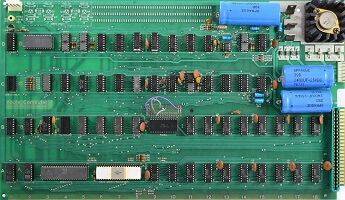 +
The final Apple-1
+
The final Apple-1
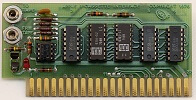 +
Apple Cassette Interface
+
Apple Cassette Interface
The final product was a mainboard with usually 4 or 8 KB and an expension slot. Later a cassette interface was created as well.
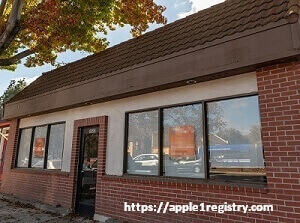 The first 50 Apple-1 computers were sold to the Byte Shop, owned by
Paul Terrell, who met Steve at the Homebrew Computer Club. Without this connection, the Apple Company might never have existed. The Byte Shop was one of the first personal computer retailers. Paul Terrell was a visionary who wanted to offer a fully assembled computer at a low price. Only later did he realize that Steve Jobs' idea of a “complete computer” meant an assembled board—keyboard, cassette interface, and tape recorder had to be purchased separately.
The first 50 Apple-1 computers were sold to the Byte Shop, owned by
Paul Terrell, who met Steve at the Homebrew Computer Club. Without this connection, the Apple Company might never have existed. The Byte Shop was one of the first personal computer retailers. Paul Terrell was a visionary who wanted to offer a fully assembled computer at a low price. Only later did he realize that Steve Jobs' idea of a “complete computer” meant an assembled board—keyboard, cassette interface, and tape recorder had to be purchased separately.
East Coast: Later, Stan Veit bought an Apple-1. He was the owner of the first computer store on the East Coast. He showcased the Apple-1 at the Association of Computer Machinery event, and initially, no one believed it was actually a computer.
According to Daniel Kottke, a car dealer once contacted Apple, expressing interest in using Apple-1 computers for his business. This was by far the most lucrative idea—but it never materialized.
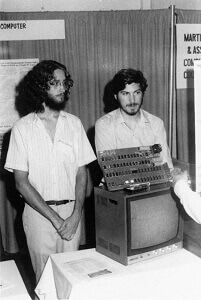
All Apple-1 computers were sold without a case, keyboard, or power supply.
The Apple-1 was first presented on August 28–29, 1976 at PC76 — the Personal Computing Consumer Trade Fair in Atlantic City, NJ, USA (black and white picture).
It was, by the way, the first national personal computer show. Steve Wozniak, Steve Jobs, and Daniel Kottke presented the Apple-1 at Stan Veit's booth.
Woz also created the first Apple II in 1976. According to Daniel Kottke, he carried the Apple II prototype in a shoebox. It was already capable of displaying color and was shown at the West Coast Computer Faire.
The Apple-1 Registry has been the original list of all known Apple-1 computers since 2010. The registry is filled with information and pictures, collected over countless hours.
This list is a recognized resource on the internet for owners, enthusiasts, Apple fans, auction houses, and the press to refer to.
Apple-1 computers are an important and rare piece of history, and the purpose of the Apple-1 Registry is to preserve information, history, location, and the condition of the few remaining Apple-1s, as too much information has already been lost or forgotten.
With some effort, an interactive Apple-1 was created. You will find an explanation of which part and chip is responsible for the various tasks of the computer.
Steve Wozniak, Apple-1 designer, engineer, co-founder of Apple Computer. Apple employee #1.
Steve Wozniak's website
Steve Wozniak talks about the Apple-1
Steve Jobs, co-founder of Apple Computer. Apple employee #2.
Ronald G. Wayne, co-founder of Apple
Ronald G. Wayne's website
Homebrew Computer Club
Apple-1 Registry - a list of all Apple-1 computers and much more
The Apple-1 - Information about the Apple-1 and a display of a private Apple-1 collection
Mike Willegal’s website. Mike created the Apple-1 Registry, which has been continued by Achim Baqué since 2018. Mike also created the famous Apple-1 replica called "Mimeo".
Applefritter, all about Apple computer and Apple-1 owner's club.
Any form of reprint or reproduction (including excerpts) only with written permission.